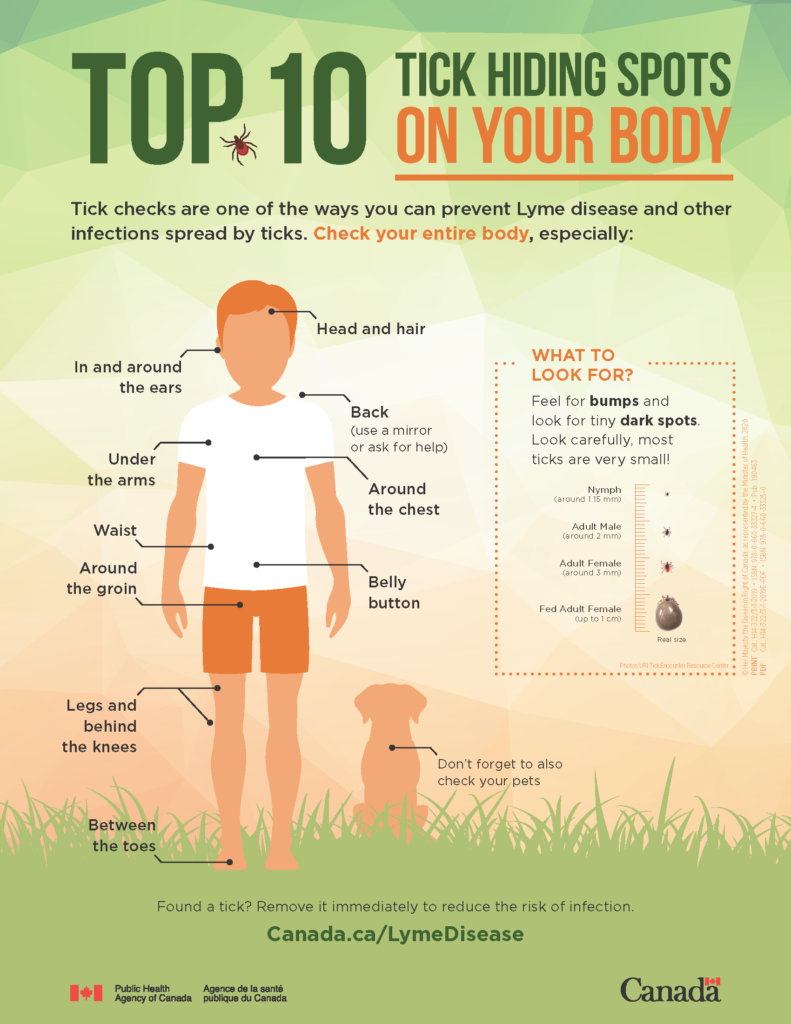 Mosquitoes are not the only insects that can make your life difficult! Beware of tick bites that can transmit Lyme disease, a disease that can lead to complications if it is not detected in time.
Mosquitoes are not the only insects that can make your life difficult! Beware of tick bites that can transmit Lyme disease, a disease that can lead to complications if it is not detected in time.
Lyme disease is caused by the bite of infected blacklegged ticks, which thrive in wooded areas. Tick bites are usually painless, and most people do not know that they have been bitten.
Lyme disease in humans can have serious symptoms such as extreme fatigue, recurring arthritis and neurological problems, but it also can be effectively treated, if caught early.
Here’s how you can protect yourself if you venture into wooded or forested areas located within risk areas for Lyme Disease:
- Shower or bathe within two hours of being outdoors to facilitate a prompt tick check and to remove ticks that have not attached yet.
- Do a daily full-body check for ticks on yourself and your children, especially in the hair, under the arms, in and around the ears, inside the belly button, behind the knees, between the legs and around the waist.
- If you find an attached tick, remove it with tweezers immediately. Removing it within 24-36 hours can help prevent infection (watch the How to properly remove a tick video for more details).
 Wear light coloured long-sleeved shirts and pants to spot ticks more easily. Tuck your shirt into your pants and pull your socks over your pant legs.
Wear light coloured long-sleeved shirts and pants to spot ticks more easily. Tuck your shirt into your pants and pull your socks over your pant legs.- Walk on cleared paths or walkways.
- Use bug spray containing DEET or Icaridin on your skin and clothing (always follow label directions).
- Do a tick check on your outdoor gear and your pets as they could carry ticks inside your home.
- Put dry outdoor clothes in a dryer on high heat for 10 minutes to kill any remaining ticks. If you need to wash your clothes first, hot water is recommended.
- If the clothes cannot be washed in hot water, tumble dry on low heat for 90 minutes or high heat for 60 minutes.
To reduce tick habitats near your home:
- Mow the lawn regularly to keep the grass short.
- Remove leaf litter, brush and weeds at the edge of the lawn and around stonewalls and woodpiles.
- Treat pets that are commonly exposed to ticks with oral or topic acaricides (as recommended by your veterinarian) as they could carry ticks into the home.
Additional Resources
● Health Canada’s Lyme Disease Prevention Toolkit online
● Canadian Lyme Disease Foundation’s Prevention, Diagnosis, and Tick Kit
● Health Canada’s Enjoy the outdoors, without a tick video.
● Top 10 Tick Hiding Spots on Your Body and Lyme Disease Surveillance in Canada – Health Canada infographics
● Public Health Agency website on Lyme Disease




















 Mosquitoes are not the only insects that can make your life difficult! Beware of tick bites that can transmit Lyme disease, a disease that can lead to complications if it is not detected in time.
Mosquitoes are not the only insects that can make your life difficult! Beware of tick bites that can transmit Lyme disease, a disease that can lead to complications if it is not detected in time. Wear light coloured long-sleeved shirts and pants to spot ticks more easily. Tuck your shirt into your pants and pull your socks over your pant legs.
Wear light coloured long-sleeved shirts and pants to spot ticks more easily. Tuck your shirt into your pants and pull your socks over your pant legs.
